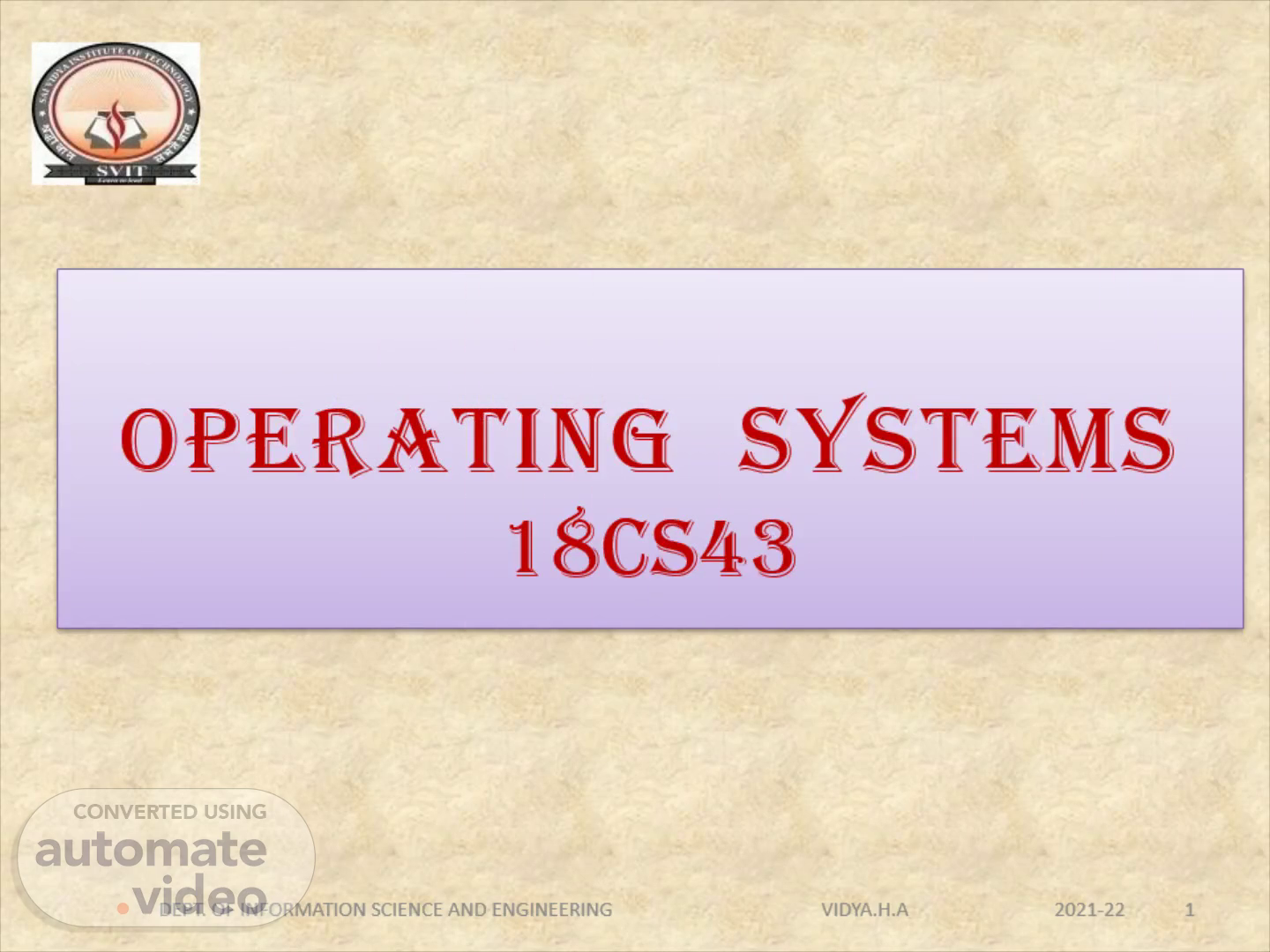
Page 1 (0s)
OPERATING SYSTEMS 18cs43. DEPT. OF INFORMATION SCIENCE AND ENGINEERING VIDYA.H.A 2021-22.
Page 2 (10s)
COURSE OUTCOMES CO 1 :Demonstrate need for OS and different types of OS . CO 2 : Apply suitable techniques for management of different resources. CO 3 : Use processor, memory, storage and file system commands. CO 4 : Realize the different concepts of OS in platform of usage through case studies..
Page 3 (31s)
Text Book: Abraham Silberschatz , Peter Baer Galvin, Greg Gagne, Operating System Principles 7th edition, Wiley-India, 2006 Reference Books: Ann McHoes Ida M Fylnn , Understanding Operating System, Cengage Learning, 6th Edition D.M Dhamdhere , Operating Systems: A Concept Based Approach 3rd Ed, McGraw- Hill, 2013. P.C.P. Bhatt, An Introduction to Operating Systems: Concepts and Practice 4th Edition, PHI(EEE), 2014. William Stallings Operating Systems: Internals and Design Principles, 6th Edition, Pearson..
Page 4 (1m 0s)
Module 1: Introduction. • What Operating Systems Do • Computer-System Organization • Computer-System Architecture • Operating-System Structure • Operating-System Operations • Process Management • Memory Management • Storage Management • Protection and Security • Distributed Systems • Special-Purpose Systems • Computing Environments • Operating System Services • User - Operating System interface; • System calls, Types of system calls; • System programs • Operating system design and implementation • Operating System structure • Virtual machines • Operating System generation; System boot..
Page 5 (1m 23s)
Module 1 Cont... • Process Management : • Process concept • Process scheduling • Operations on processes • Inter process communication.
Page 6 (1m 33s)
What is an Operating System?. • A program that acts as an intermediary between a user of a computer and the computer hardware • Operating system : (User View) – Execute user programs and make solving user problems easier – Make the computer system convenient to use – Use the computer hardware in an efficient manner.
Page 7 (1m 49s)
Computer System Structure. Computer system can be divided into four components – Hardware – provides basic computing resources • CPU, memory, I/O devices Operating system • Controls and coordinates use of hardware among various applications and users Application programs – define the ways in which the system resources are used to solve the computing problems of the users • Word processors, web browsers, database systems, video games Users • People, machines, other computers.
Page 8 (2m 10s)
Four Components of a Computer System. DEPT. OF INFORMATION SCIENCE AND ENGINEERING VIDYA.H.A 2021-22.
Page 9 (2m 18s)
Operating System : System View • OS is a resource allocator – Manages all resources , Decides between conflicting requests for efficient and fair resource use • OS is a control program – Controls execution of programs to prevent errors and improper use of the computer • The one program running at all times on the computer is the kernel..
Page 10 (2m 37s)
Computer Startup • bootstrap program is loaded at power-up or reboot – Typically stored in ROM or EPROM, generally known as firmware – Initializes all aspects of system – Loads operating system kernel and starts execution.
Page 11 (2m 50s)
Computer-System Operation • I/O devices and the CPU can execute concurrently • Each device controller is in charge of a particular device type • Each device controller has a local buffer • CPU moves data from/to main memory to/from local buffers • I/O is from the device to local buffer of controller • Device controller informs CPU that it has finished its operation by causing an interrupt.
Page 12 (3m 11s)
DEPT. OF INFORMATION SCIENCE AND ENGINEERING VIDYA.H.A 2021-22.
Page 13 (3m 18s)
Common Functions of Interrupts. • Interrupt transfers control to the interrupt service routine generally, through the interrupt vector, which contains the addresses of all the service routines.
Page 14 (3m 30s)
Interrupt Handling • The operating system preserves the state of the CPU by storing registers and the program counter • Determines which type of interrupt has occurred : – polling – vectored interrupt system • Separate segments of code determine what action should be taken for each type of interrupt.
Page 15 (3m 45s)
I/O Structure • After I/O starts, control returns to user program only upon I/O completion – Wait instruction idles the CPU until the next interrupt – Wait loop (contention for memory access) – At most one I/O request is outstanding at a time, no simultaneous I/O processing • After I/O starts, control returns to user program without waiting for I/O completion – System call – request to the operating system to allow user to wait for I/O completion – Device-status table contains entry for each I/O device indicating its type, address, and state – Operating system indexes into I/O device table to determine device status and to modify table entry to include interrupt.
Page 16 (4m 17s)
DEPT. OF INFORMATION SCIENCE AND ENGINEERING VIDYA.H.A 2021-22.
Page 17 (4m 26s)
Computer-System Architecture Single Processor System Multiprocessor system Clustered system.
Page 18 (4m 35s)
DEPT. OF INFORMATION SCIENCE AND ENGINEERING VIDYA.H.A 2021-22.